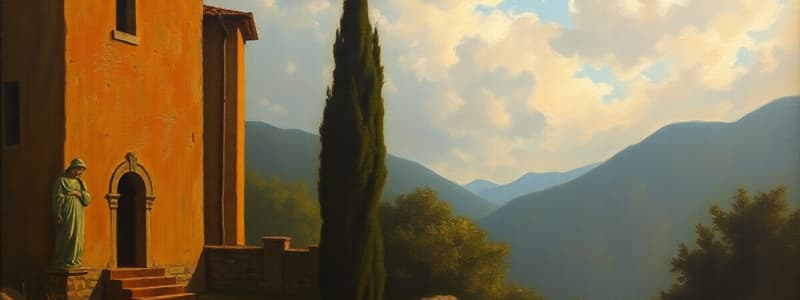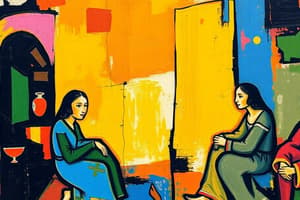Podcast
Questions and Answers
People in the Renaissance were capable of achievements and ______.
People in the Renaissance were capable of achievements and ______.
creativity
During the Renaissance, there was an eagerness to search for ______.
During the Renaissance, there was an eagerness to search for ______.
truth
Renaissance art often depicted natural landscapes and ______.
Renaissance art often depicted natural landscapes and ______.
life
The technique of ______ was significant in Renaissance paintings, allowing for depth and realism.
The technique of ______ was significant in Renaissance paintings, allowing for depth and realism.
Renaissance paintings were characterized by their use of diverse and ______ colours.
Renaissance paintings were characterized by their use of diverse and ______ colours.
People during the Renaissance had freedom in their ______.
People during the Renaissance had freedom in their ______.
Renaissance artwork included themes from religion, daily life, and ______-Roman myths.
Renaissance artwork included themes from religion, daily life, and ______-Roman myths.
The famous painting 'Mona Lisa' is a notable work from the ______ period.
The famous painting 'Mona Lisa' is a notable work from the ______ period.
The Renaissance literally means 'rebirth' in ______.
The Renaissance literally means 'rebirth' in ______.
The Renaissance started in ______, an Italian city-state.
The Renaissance started in ______, an Italian city-state.
Renaissance scientists proved that the old teachings were ______.
Renaissance scientists proved that the old teachings were ______.
During the Renaissance, people became more interested in ______ instead of just agriculture.
During the Renaissance, people became more interested in ______ instead of just agriculture.
The decline of the ______ contributed to the Renaissance by weakening its power.
The decline of the ______ contributed to the Renaissance by weakening its power.
Scientists like Copernicus discovered that the Earth goes around the ______.
Scientists like Copernicus discovered that the Earth goes around the ______.
People in the late Middle Ages started doubting the ______ due to corruption and new ideas.
People in the late Middle Ages started doubting the ______ due to corruption and new ideas.
Bruno improved the ______ and supported Copernicus' theories.
Bruno improved the ______ and supported Copernicus' theories.
The Renaissance was marked by a renewed interest in ______ civilization and learning.
The Renaissance was marked by a renewed interest in ______ civilization and learning.
Galileo proposed that objects fall at the same speed regardless of their ______.
Galileo proposed that objects fall at the same speed regardless of their ______.
Medieval towns became rich due to increased ______ between Europe and Asia.
Medieval towns became rich due to increased ______ between Europe and Asia.
Vesalius studied the structure of the human ______.
Vesalius studied the structure of the human ______.
William Harvey discovered that blood flowed into the heart like a ______.
William Harvey discovered that blood flowed into the heart like a ______.
With the establishment of universities, people began to study subjects other than ______.
With the establishment of universities, people began to study subjects other than ______.
The use of ______ languages during the Renaissance allowed more people to express themselves freely.
The use of ______ languages during the Renaissance allowed more people to express themselves freely.
Renaissance scientists showed critical and independent ______ by challenging the Church’s teachings.
Renaissance scientists showed critical and independent ______ by challenging the Church’s teachings.
Flashcards
What was the Renaissance?
What was the Renaissance?
The Renaissance was a period of major cultural and intellectual change in Europe, lasting from the 1300s to the 1500s. It marked a transition from the Middle Ages to Modern times.
Where did the Renaissance begin?
Where did the Renaissance begin?
The Renaissance originated in Florence, an Italian city-state, and then spread to the rest of Europe.
What were the key interests of the Renaissance?
What were the key interests of the Renaissance?
During the Renaissance, people became more interested in science, art, and humanities, compared to the medieval focus on agriculture, feudalism, and religion.
What was 'reborn' during the Renaissance?
What was 'reborn' during the Renaissance?
Signup and view all the flashcards
How did the Church's decline contribute to the Renaissance?
How did the Church's decline contribute to the Renaissance?
Signup and view all the flashcards
How did Church corruption lead to its decline?
How did Church corruption lead to its decline?
Signup and view all the flashcards
How did the decline in feudalism contribute to the Renaissance?
How did the decline in feudalism contribute to the Renaissance?
Signup and view all the flashcards
What role did universities play in the Renaissance?
What role did universities play in the Renaissance?
Signup and view all the flashcards
Human Nature in the Middle Ages
Human Nature in the Middle Ages
Signup and view all the flashcards
Human Nature in the Renaissance
Human Nature in the Renaissance
Signup and view all the flashcards
Religious Thinking in the Middle Ages
Religious Thinking in the Middle Ages
Signup and view all the flashcards
Religious Thinking during the Renaissance
Religious Thinking during the Renaissance
Signup and view all the flashcards
Life in the Middle Ages
Life in the Middle Ages
Signup and view all the flashcards
Life during the Renaissance
Life during the Renaissance
Signup and view all the flashcards
Medieval Art
Medieval Art
Signup and view all the flashcards
Renaissance Art
Renaissance Art
Signup and view all the flashcards
Why did the use of vernacular languages spread during the Renaissance?
Why did the use of vernacular languages spread during the Renaissance?
Signup and view all the flashcards
How did scientific discoveries impact the Church's authority during the Renaissance?
How did scientific discoveries impact the Church's authority during the Renaissance?
Signup and view all the flashcards
What was Copernicus's groundbreaking discovery?
What was Copernicus's groundbreaking discovery?
Signup and view all the flashcards
How did Bruno's work contribute to the acceptance of Copernicus' ideas?
How did Bruno's work contribute to the acceptance of Copernicus' ideas?
Signup and view all the flashcards
What were Galileo's key contributions to science?
What were Galileo's key contributions to science?
Signup and view all the flashcards
What was Vesalius's contribution to the understanding of the human body?
What was Vesalius's contribution to the understanding of the human body?
Signup and view all the flashcards
What was Harvey's crucial discovery about the circulatory system?
What was Harvey's crucial discovery about the circulatory system?
Signup and view all the flashcards
Why is the Renaissance a time of intellectual freedom?
Why is the Renaissance a time of intellectual freedom?
Signup and view all the flashcards
Study Notes
Renaissance Timeline
- Ancient Times: Fall of Western Roman Empire (476 AD)
- Medieval Times: Fall of Eastern Roman Empire (1453 AD)
- Modern Times: Columbus Arrives in America (1492 AD)
Renaissance Background
- The Renaissance took place from the 1300s to 1500s, marking a transition from the Medieval to Modern periods.
- "Renaissance" literally means "rebirth" in French.
- It began in Florence (Italy) and spread across Europe.
- Greco-Roman civilization and knowledge were revived.
Before Renaissance
- People were primarily interested in agriculture, feudalism (protecting their lord), and religion.
- Learning and scientific inquiry were limited.
- Opposition to the Church could result in accusations of heresy.
After Renaissance
- People became more interested in science, arts, humanities, and architecture.
- People were willing to question the Church's teachings and practices.
Reasons for the Renaissance - The Decline of the Church
- Early Middle Ages: People were faithful Christians, religious, and obedient. The Church was powerful politically, economically, and culturally.
- Late Middle Ages: Churchmen became corrupted. Questions arose regarding church teachings. People sought better ways to worship and gained knowledge about the Muslim World.
Decline of Feudalism
- Trade between Europe and Asia increased, enriching merchants.
- Peasants moved to towns for better job opportunities.
- Loss of life due to the Black Death weakened the nobility's power and control over serfs.
- People were liberated from feudal structures and questioned traditional beliefs.
Invention of the Printing Press
- Johannes Gutenberg's invention of the movable metal type printing press revolutionized book production.
- This made books more accessible and affordable, leading to the spread of knowledge and ideas.
Humanism
- Intellectual movement that focused on human potential, values, abilities, creativity, and freedom.
- Contrasted with the previous focus on religion and the afterlife.
Summary of Changes
- Increased knowledge of the world, scientific discoveries.
- People questioned traditional beliefs, and challenged the church.
- Encouraged independent thinking and creativity.
- Increased interest in the present life and human achievements.
- Rise of human focus in art, architecture, and literature
Art Developments and Reflections
- Medieval paintings: Golden/darker, dimmer colours, primarily religious themes.
- Renaissance paintings: Diverse colours, greater interest in nature, religion, daily life, Greco-Roman myths.
- Techniques: None to note
- Human Figures: Medieval- rigid and flat, Renaissance- lively and realistic.
- Famous works: Diptych of the Virgin and Child Enthroned, Mona Lisa
Architecture Developments and Reflections
- Medieval architecture: Pointed spires, long and narrow windows, pointed arches, vaulted roofs, stained glass
- Renaissance architecture: Large round domes, tall columns, pediments, round arches, stained glass
Spirit of Renaissance
- Everyday life became a subject of writings and works of art (not just about religion and the afterlife)
- Showed their interest in earthly life
- Reflected human values and emotions
- Criticized injustice in society
- Showed critical and independent thinking of humans
Science
- Scientists & Areas of Study: Copernicus, Bruno, Galileo, Vesalius, and William Harvey - Astronomy, Physics, Anatomy, and Biology
- Discoveries: The Earth revolves around the sun, improved telescopes, studied the universe, human anatomy
- Church's viewpoint: The Earth is flat and is the center of the universe.
Impact of Renaissance
- Humanism: Focused on human potential, values, and achievements instead of solely focusing on religion or afterlife.
- Life improvements: interest in the world outside. voyages of discovery, exchanged items across places. proofs of great achievements.
Reformation of the Church
- Martin Luther questioned the practices of the Catholic Church and challenged its authority.
- Nailing the 95 Theses to the church door.
- Use of the printing press.
- Spread of his ideas and translations of the Bible.
The French Revolution & Napoleon
- Causes: Inequality, influence of the American Revolution, inefficient government.
- Main Criticism: Autocratic government, social inequality, economic suffering, and corruption.
Important Events - French Revolution
- Meeting of the Estates-General
- Tennis Court Oath
- Storming of the Bastille
- Declaration of the Rights of Man
- Louis XVI attempted to flee but failed
- Louis XVI was executed by guillotine.
Initial Developments of the French Revolution
- Major Enlightenment ideas
- Basic human rights
- Equality before law
- Popular sovereignty.
Napolean Era
- Internal Causes: The Directory's corruption and inability to solve social-economic problems led to discontent and desire for a strong leader.
- External Causes: Defeated the First Coalition, brought glory to France, and was a national hero. The First Italian Campaign, success in invading Italy and defeating the Austrians, influential in French politics
- Achievements: Built a huge empire and was a master of Europe. Invaded Egypt, but was defeated by the British Navy.
Downfall of Napoleon
- Causes: Spanish people revolted, Napolean punished Portugal refusing to abide by continental systems, The Russian Campaign failure of resources, etc.
- Results: Napoleon was defeated.
Significance of Nationalism and Liberalism
- Nationalism: Movement focused on unifying people of the same cultural and religious background and forming independent countries; encouraged independence and unification movements in the 19th century.
- Liberalism: Movement focused on liberty and equality; encouraged outbreak of revolutions and demands for political rights and constitutions across various nations in the 19th century.
Studying That Suits You
Use AI to generate personalized quizzes and flashcards to suit your learning preferences.



